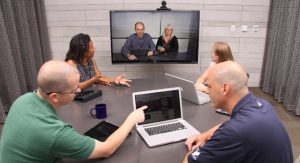L A T E S T P O S T S
-
Why Our Growing Dependence On Technology In Schools Is Not Always A Good Thing
-
Education Technology Is Bigger And Better Than It Has Ever Been
-
Empowering EdTech To All New Heights
-
أهم ما ينبغي معرفته قبل اختيار شركة التداول في الأردن!
-
EdTech changing the world of academics
-
Education technology pioneering the future workforce into motion
-
EdTech is influencing education
-
Edtech – making sure your children gets the education they deserve
-
Taking education to a new standard with the digital classroom
-
Millennials are combining education and technology
The Voice of Technology in the Classroom
George Couros, Canadian educator of innovative teaching says, “Technology will never replace great teachers, but technology in the hands of great teachers is transformation.”
To be sure, teaching was a totally different experience a generation ago. That was an age where teachers alone possessed information and presented it to students in the classroom, and students absorbed it. Today, much of what the teacher presented in days of yore, is available to students online. Therefore, teachers are now recreating their role in the classroom, with the aid of technology.
Teachers no longer spoon-feed information during school hours. Instead, they use technology to assist students in solving problems, in enhancing and collaborating in the learning process. Says Andrew Kim, a Steelcase WorkSpace Futures researcher, “More and more, classrooms are becoming places where knowledge is created versus consumed by students.”
However, two surveys of teachers undertaken in recent times, one by the Pew Research Center in Washington DC, and the other by Common Sense Media, a nonprofit based in San Francisco, California, reveal the existence of a widespread belief among teachers that students using digital technology with such frequency is hindering their attention spans and ability to persevere in the face of challenging tasks. Associate director for Research at Pew, Kristen Purcell, says that there is another perspective to these research findings – that is, the education system needs to change according to the way students learn. She said, ““What we’re labeling as ‘distraction,’ some see as a failure of adults to see how these kids process information. They’re not saying distraction is good but that the label of ‘distraction’ is a judgment of this generation.”
The students of today grew up with digital technology, and it is part of their daily lives, and so, a vital component of their educational process. Today’s students have become more independent in the classroom than in the past, and expect technology to be a requirement in education, rather than an added benefit from the school system. The corporate world is an added ally in this process, as they provide complementing apps to help the students in their quest for knowledge, while aiding teachers in a changing teaching environment.
New technologies in schools are always considered an extension of teaching, an enhancement of what the teacher provides rather than something to replace the teacher. Technology helps in lesson preparation, simplifying the teacher’s task. Teachers also use technology as an aid to assessing students. There are apps like ClassFlow which allow the teacher to determine how well the class has understood a particular lesson. It allows the teacher to determine how well individual students have comprehended the lesson, and, in turn, the teacher is able to provide appropriate feedback to students. Technology has helped break down the boundaries of the four-walled classroom, allowing students and teachers to share ideas and collaborate in ways that were not possible before.
With the advent of technology, learning at all levels is happening remotely as well as onsite. For instance, students access content online away from their classrooms and use the knowledge in the classroom subsequently, by engaging in discussions or group work. As Andrew Kim says, “What’s interesting is that as learning is becoming more virtual, the virtual activities are actually becoming more physical. You might say the virtual and the physical are meeting in the middle.”
And so, it is obvious that technology will not replace teachers. However, teachers who use technology will probably replace those who don’t.
| Have an article to contribute to Union? Email us. |
Tertiary Cybercrime is a Real Threat
 Cybercrime in general has been on the rise in 2017, but universities have been increasingly amongst the targets, with the education sector seeing first-hand the effects of the growing sophistication of hackers and digital criminals.
Cybercrime in general has been on the rise in 2017, but universities have been increasingly amongst the targets, with the education sector seeing first-hand the effects of the growing sophistication of hackers and digital criminals.
In July, Newcastle University in the UK fell victim to a phishing scam in the form of a website fraudulently operating using its name and logo. And Canadian based MacEwan University lost 11.8 million thanks to an email scam which phished for the universities financial details by sending emails to staff requesting they update account details with current vendors. Africa too has faced an increase in attacks, with Zimbabwe’s National University of Science and Technology amongst the most recent targets.
But it isn’t only phishing which poses a cyber security risk for universities.
Cyber criminals are also launching hundreds of attacks against the world’s leading institutions every year, attempting to steal university research. The primary areas of interest to digital thieves are medical and engineering records and research. FOI’s obtained by The Times showed that Oxford experienced 515 cases of unauthorized access to accounts in 2016, and the research targeted varied from medical advances to military grade stealth fabrics.
What makes tertiary educational institutions such a common target? It’s thanks in part to the massive staff email servers and intranet which keep universities connected, which provide multiple entry points for a trojan, or phishing scam, to take hold.
And on top of that, there’s also the coming and going of hundreds of laptops, smartphones, tablets, music players and a range of other digital devices carried in and out by students, staff and contractors, every day.
Experts agree that the best way to prevent these sorts of scams is education, the institution as a whole has to learn to back up data and to beware of phishing emails. Ensuring that staff and students at universities understand the need for patch-management and proper cyberhygiene is one of the easiest ways to keep sensitive data and research safe.
But there are other methods available to help protect against cybercrime. An obvious way to help prevent phishing and email scams, is to ensure they have the best SSL certificates available, which offer high-authentication methods to differentiate real websites from fake ones.
Responsiveness in the moment is also something which universities can struggle with when it comes to dealing with a digital threat. Well-developed incident management plans can assist with controlling losses and mitigating damages.
Monitoring systems that regularly scan and quarantine Malware are just as vital for large, interconnected networks as home networks, if not more so. Universities should be investing in the right protection software if they want to keep their users and data safe.
The unique threats posed to universities from cybercrime are only going to increase as the complexity and cunning of hackers and malware developers continues to increase. Through 2017 and beyond, the question of cyber security should be a major issue on the board of tertiary institution across the globe.
| Have an article to contribute to Union? Email us. |
How Collaborative Tech is Disrupting Traditional Learning Models
Collaborative technology has changed our lives in so many ways. Enriching personal relationships, by connecting us with far away friends or family members. Improving productivity and flexibility in businesses by linking remote sites or workers with one another. But one area where collaborative tech is really making a splash, is education.
Educators have been talking about how E-Learning initiatives have been changing the face of the traditional classroom since 2013, and we’re starting to see the effects of the digital revolution on education institutions now. From iPads and webcams in kindergarten classrooms to cross-cultural learning opportunities. Today over half of America’s K-12 students are using Google’s suite of collaborative apps to help them with their studies.
Studies have shown that students excel when they’re given interactive opportunities that allow them to immersive themselves in what they’re learning and thanks to the power of the internet and technological advances like cloud storage, video streaming and mobile devices, the world has become our classroom no matter where we are. It’s no wonder collaborative tech is making waves in the education sector where engagement is such a vital part of the learning experience.
Companies like Blackboard and Coursera are providing teachers with innovative new ways to deliver lessons and class materials, while students can interact with each other, sharing their class notes using Dropbox, or using Skype to meet up for group assignments outside of class hours, without having to leave the house.
One way it does this is by making it easier and more convenient to gain new skills and qualifications. Thanks to online learning students can receive a high-quality teaching and learning experience, regardless of where they live, and this has been a game-changer in providing equal opportunities to rural and disadvantaged communities.
Asian countries, like China have seen a boom in the ESL market thanks to virtual classrooms connecting students with native English speakers overseas, while the Australian job market is predicted to receive a major influx of qualified workers thanks to the prevalence of MOOC platforms, or Massive Open Online Courses.
Even professional certifications are becoming easier for employees to obtain, with businesses now able to offer online solutions for staff to train both on the job, or at home, providing some much-needed flexibility in today’s busy work place.
Collaborative technology is also training students to adapt to the changing environment of the modern workspace, encouraging them to think co-operatively regardless of distance, or provide hands-on assistance even if they’re in a remote location. The skills necessary for success in the 21st Century are undoubtedly based around technology, giving students the opportunities to interact with the growing range of collaborative apps and programs out there will enable them to be digitally savvy employees when they eventually graduate to the workplace.
As the number of collaborative options on the market continues to grow, and the market for these technologies continues to expand we’re likely to see more and more innovations that provide us with connective and communal ways to engage with learning.
| Have an article to contribute to Union? Email us. |
What to Consider When Applying for an Online Course
 Depending on what you are interested in or do for a living, there are numerous courses that you can pick up to polish your skills. However, there are also a few things you should consider before you dive head first into something that catches your eye.
Depending on what you are interested in or do for a living, there are numerous courses that you can pick up to polish your skills. However, there are also a few things you should consider before you dive head first into something that catches your eye.
- Money
Most of the courses online are free of charge or require little to no effort on the potential student’s part to gain access, such as inviting friends to sign up or sharing the course. Skillshare is one of these platforms. Others provide courses at the fraction of the price of a degree. This allows individuals with a higher flexibility to learn whatever skills they may require, depending on their line of work. For example, a blogger could apply for a photography class and learn how to take better photos for their image; a florist or baker might benefit from learning calligraphy to offer their clients with quality products; or a business owner may pick up e-commerce in order to understand digital advertising and better market their services and wares.
- Time
Being able to customize one’s schedule definitely helps in terms of meeting due dates or course completion. One may even go through an entire online class in a matter of hours, if ever so inclined. And if reports of career instability as illustrated by Express UK are to be our future, we need to constantly enhance ourselves in order to maintain a job; not necessarily at the same company but creating opportunities for employability. Furthermore, a degree will usually take roughly three years to complete, whereby an online course can be completed within weeks or months; thus being time-effective.
- Variety
As implied above, the future of employment is uncertain at most. According to the World Economic Forum Future of Jobs Report, we will not have the job positions we have today, in 2020. It is predicted that many of the jobs will focus on human relations, such as Service Orientation or People Management.
- Certification
While the world progresses into automated forms of technology, experience and knowledge may beat out on high education certifications unless someone has the foresight to meet future demands. Therefore, even though the skills you have developed are not bestowed by an established institution, the world should have grown enough to recognize self-taught talents are no less qualified. Or, they will have to. Especially when it’s something as niche as Machine Learning using Python Training. Python being one of the world’s top programming systems.
- Interest
In our modern day and age, there are certain skill sets we should develop in order to stay ahead of the learning curve. We have moved past the era of basic HTML, and entering a world where programming is an essential skill to have. It is instinctive to choose a field where your passions lie, but sometimes they do not align with what is crucial to our survival. Online courses give us the option to invest in ourselves affordably, without taking up too much of our time and therefore, allows for progression.
| Have an article to contribute to Union? Email us. |
5 rising startups in the education sector
The rapid evolution of technology has created new methods of delivering education to students to the extent that some authors have even predicted the end of colleges as we know them.
Numerous entrepreneurs are now focusing their energies on hacking the education industry in a scalable way.
The use of technology in the education sector has been consistently growing. Some even claim it may be growing a little too fast.
Nevertheless, the eLearning space remains one of the hottest spaces in tech with a myriad of innovative tools ranging from software to mobile applications and online portals/platforms.
If building an eLearning startup is somewhere in your bucket list journal, here are 5 edtech startups that are developing innovative products and ideas that you should probably take note of.
1) Quipper
Quipper envisions a society where all students (even those living in rural areas) are given the opportunities to learn from the best tutors and access quality. This startup provides an online learning platform that supports teachers in class management at primary and secondary school levels.
This UK-born platform equips teachers with the ability to build lessons online, connect directly with students, delegate tasks and more.
2) BYJU’s: The learning App
This application was designed with a vision to increase the pace of learning among the students by bringing interactive activities and engaging animated videos into the delivery of educational content.
The startup managed to raise $50 million from Sequoia Capital and The Chan Zuckerberg initiative (CZI) among other investors.
In September 2016, the app crossed the 5 million download mark.
3) Embibe
This online portal enables AIPMT, CET, JEE, BITSAT and AIIMS students to prepare for tests and is specially catered to engineering entrance examinations.
Receiving $4 million in funding, this startup focuses on analytics and content to get the most important information at the right time to students and claims to have more than 15,000 users.
4) Kahoot!
The top education app on the UK and US Apple app stores, users can create a fun learning game in just a few minutes and play them in groups with each player answer the questions on his/her own device (smartphone…etc) while the game is displayed on a shared screen.
Teachers can also create their own games and quizzes on the platform.
The app now has 50 million users every month.
5) Simplilearn: Get Certified, Get Ahead
Catered to working professionals who want to advance their careers or simply pick up a new skill, the platform has over 400 courses in big data, programming and more.
It is one of the world’s leading certification training providers and has helped over 500,000 companies and professionals in more than 150 countries get.
The startup raised $15 million in Series C funding and rose to a funding total of $28 million.
| Have an article to contribute to Union? Email us. |
Where Can a Marketing Degree Get Our Students in 2017?
The Marketing professionals are increasingly involved in jobs that are not only directly related to their degree, but which also require a wider range of skills and knowledge. This has resulted in more options being available to a marketing graduate. Some of the popular job options available in marketing are:
1) Marketing Manager, or a marketing “all-rounder,” who has a broad range of skill set, including strategic thinking, and deep understanding of full marketing picture.
2) Brand Marketing Manager, who works with a branding agency, or acts as an in-house branding expert.
3) Marketing copywriter, who creates online and offline marketing contents for the organisation.
4) Social Media Specialist, who manages various social media platforms with customer-focused writing.
Social media and digital marketing – as noted by Impressive Digital Managing Director Robert Tadros – is one of the most highly sought skills from fresh graduates in today’s job market. Many high paying marketing jobs are available, especially to those who have international experience, and can understand various culture and media strategies together with newer channels. In addition, marketing salaries are highest for those in revenue-generating positions. Some of the top earning marketing jobs include:
1) International Marketing Executive, who is responsible for planning and directing international marketing strategies to capture audience attention in different cultures, markets and channels.
2) Top Channel Development Executive, who runs channel development in ways that maximize revenues
3) Marketing Executive, who can quickly adapt their company’s strategies and philosophies across a wide variety of ever-changing channels.
Forbes adds names such as Cadence Design, Juniper Network, The Coca Cola Company, Marvell Technology and Oracle to the list of organisations that pay the most for marketing jobs.
However, jobs in marketing are constantly evolving and the student of marketing can land up many exciting new job options in the future. According to content marketing influencer, Steve Olenski, some of the future marketing jobs are:
1) Chief Experience Officer, who will oversee development and implementation of products, services, and communication of user experience.
2) Augmented Reality Producer, who will engage with alternative methods of communication with the aid of technology, to help consumer virtually try products or services.
3) Lead Data Analyst, who will analyse and interpret marketing data.
| Have an article to contribute to Union? Email us. |
Are We Designing Girls Out of Education Technology?
This week, a software engineer at Google was fired for writing a widely-derided internal memo, critiquing the company’s diversity efforts for ignoring the “fact” that women are just biologically different from men. The author of the 10-page memo claimed, among other things, that women are innately less competitive than men—and that these differences are “universal across human cultures.”
As damaging as it may be to perpetuate ideologies predicated on a belief that biology holds women back, the memo forces a tough and important conversation about the systems and motives that undergird our behavior. And, more importantly, what we can do about it.
Because while the demographics of the tech industry may reinforce the author’s notion in a world where our collective experiences make the theory easy to accept, it takes very little Googling to discover cultures that prove the memo’s author to be wrong.
Much has been written about Northern India’s Khasi tribe, for example, which traces ancestry through maternal—rather than paternal—lineage. In “The Why Axis,” economists Uri Gneezy and John List examined the Khasis in the context of a broader discussion about the structures and incentives that lead to inequitable outcomes, from the workplace to the playground.
More importantly, the authors shine a light on hidden motives or unexpected causes of suboptimal societal outcomes. In one experiment, auto mechanics charged a wheelchair-bound person more for repairs—not because of implicit or explicit bias, but because they assumed someone with limited mobility would be less likely to shop around. When the customer in a wheelchair announced he was getting multiple bids for the work, the pricing offered was identical to that offered to other customers.
It’s a body of work that may be especially relevant to an edtech community with the potential to shape norms that influence tomorrow’s workplace. But it’s easy to overlook if we don’t think purposefully about gender during a design process.
In an experiment with Tanzania’s Masai tribe, an intensely patrilineal society, Gneezy and List asked participants to choose between trying to win some money by successfully throwing a tennis ball into a bucket, or winning larger sums by playing the same game against another person. Half of the male participants chose the competitive option, while only 26 percent of women did. When the same exercise was carried out in the matrilineal Khasi tribe, 54 percent of women chose to compete, while only 39 percent of the men did.
The experiments disprove the central tenet of the Google engineer’s memo—that women are biologically wired to cooperate, not compete. They help us to understand the impact of culture on an individual’s proclivity to compete, identify reasons for gender differences in competition, and create an opportunity to craft cultures that nurture our cooperative and competitive instincts.
Last year, an all-girls team from Michigan called the Pink Eagles won our global robotics competition. Siena Molinaro and Ena Garza from McAllen, Texas won third place. Overall, girls made up 44 percent of the 20,000 competitors across 52 countries, and 35 percent of overall participants in the younger (6-8) age bracket.
Enthusiasm among girls for the competition wasn’t an accident. Early tests of our robots revealed that girls tended to view robots with wheels as toys for boys. As a result, we opted to hide the wheels—placing them underneath the robot’s body. It’s a seemingly minor aesthetic difference, but one—among many—with real ramifications for increasing the appeal of computer science for both boys and girls. Our design process also led us to give our robots one eye and three legs to make it look like nothing else on Earth. It’s not a bug, puppy or anything else that may appeal more to one sex than the other. With our robotics competition, we focused on solving a problem, rather than creating a battle bot-style competition, to attract a broad swath of students.
Yet purposeful design in education isn’t about simplistic choices like making Legos pink or exploiting what author Peggy Orenstein describes as “gendered play patterns,”—the assumption that girls will be more interested in building a Lego hair salon or cafe than a Millennium Falcon. It’s about focusing on storytelling, music, and games that appeal to both girls and boys. It’s about making sure children feel like they belong—and searching for data that might challenge long-held assumptions about their behavior.
Of course, it shouldn’t take the Pink Eagles or Khasis to show us that girls are as innately competitive as boys. Or a misguided memo to spark debate about how and whether, in the Silicon Valley, right-leaning views may be marginalized, ignored or unfairly characterized. We do better as designers and entrepreneurs when we create products that reflect aspirations rather than norms, and with the mindset that whether or not we change each other’s point of view, we will come away wiser from the debate.
| Have an article to contribute to Union? Email us. |




